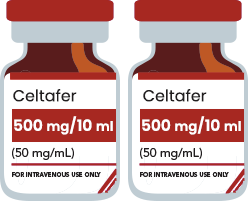IMPORTANT SAFETY INFORMATION
INDICATIONS
Celtafer® (ferric carboxymaltose injection) is indicated for the treatment of iron deficiency anemia (IDA) in adult and pediatric patients 1 year of age and older who have either intolerance or an unsatisfactory response to oral iron, and in adult patients who have non-dialysis dependent chronic kidney disease. Celtafer is also indicated for iron deficiency in adult patients with heart failure and New York Heart Association class II/III to improve exercise capacity.
CONTRAINDICATIONS
Celtafer is contraindicated in patients with hypersensitivity to Celtafer or any of its inactive components.
WARNINGS AND PRECAUTIONS
Symptomatic Hypophosphatemia
Symptomatic hypophosphatemia with serious outcomes including osteomalacia and fractures requiring clinical intervention has been reported in patients treated with Celtafer in the post-marketing setting. These cases have occurred mostly after repeated exposure to Celtafer in patients with no reported history of renal impairment. However, symptomatic hypophosphatemia has been reported after one dose. Possible risk factors for hypophosphatemia include a history of gastrointestinal disorders associated with malabsorption of fat-soluble vitamins or phosphate, inflammatory bowel disease, concurrent or prior use of medications that affect proximal renal tubular function, hyperparathyroidism, vitamin D deficiency, malnutrition, and hereditary hemorrhagic telangiectasia (HHT or Osler-Weber-Rendu syndrome). In most cases, hypophosphatemia resolved within three months.
Correct pre-existing hypophosphatemia prior to initiating therapy with Celtafer. Monitor serum phosphate levels in patients at risk for chronic low serum phosphate. Check serum phosphate levels prior to a repeat course of treatment in patients at risk for low serum phosphate and in any patient who receives a second course of therapy within three months. Treat hypophosphatemia as medically indicated.
Hypersensitivity Reactions
Serious hypersensitivity reactions, including anaphylactic-type reactions, some of which have been life-threatening and fatal, have been reported in patients receiving Celtafer. Patients may present with shock, clinically significant hypotension, loss of consciousness, and/or collapse. Monitor patients for signs and symptoms of hypersensitivity during and after Celtafer administration for at least 30 minutes and until clinically stable following completion of the infusion. Only administer Celtafer when personnel and therapies are immediately available for the treatment of serious hypersensitivity reactions. In clinical trials, serious anaphylactic/anaphylactoid reactions were reported in 0.1% (2/1775) of subjects receiving Celtafer. Other serious or severe adverse reactions potentially associated with hypersensitivity which included, but were not limited to, pruritus, rash, urticaria, wheezing, or hypotension were reported in 1.5% (26/1775) of these subjects.
Hypertension
In clinical studies, hypertension was reported in 4% (67/1775) of subjects in clinical trials 1 and 2. Transient elevations in systolic blood pressure, sometimes occurring with facial flushing, dizziness, or nausea were observed in 6% (106/1775) of subjects in these two clinical trials. These elevations generally occurred immediately after dosing and resolved within 30 minutes. Monitor patients for signs and symptoms of hypertension following each Celtafer administration.
Laboratory Test Alterations
In the 24 hours following administration of Celtafer, laboratory assays may overestimate serum iron and transferrin bound iron by also measuring the iron in Celtafer.
ADVERSE REACTIONS
Adults
In two randomized clinical studies [Studies 1 and 2], a total of 1775 patients were exposed to Celtafer, 15 mg/kg of body weight, up to a maximum single dose of 500 mg of iron on two occasions, separated by at least 7 days, up to a cumulative dose of 1000 mg of iron. Adverse reactions reported by >2% of Celtafer-treated patients were nausea (7.2%); hypertension (4%); flushing (4%); injection site reactions (3%); erythema (3%); hypophosphatemia (2.1%); and dizziness (2.1%).
Patients with Iron Deficiency and Heart Failure
The safety of Celtafer was evaluated in adult patients with iron deficiency and heart failure in randomized controlled trials FAIR-HF (NCT00520780), CONFIRM-HF (NCT01453608) and AFFIRM-AHF (NCT02937454) in which 1016 patients received Celtafer versus 857 received placebo. The overall safety profile of Celtafer was consistent across the studied indications.
Post-Marketing Experience
The following adverse reactions have been identified during post approval use of Celtafer. Because these reactions are reported voluntarily from a population of uncertain size, it is not always possible to reliably estimate their frequency or establish a causal relationship to drug exposure.
The following adverse reactions have been reported from the post-marketing spontaneous reports with Celtafer: cardiac disorders: tachycardia; general disorders and administration site conditions: chest discomfort, chills, pyrexia; metabolism and nutrition disorders: hypophosphatemia; musculoskeletal and connective tissue disorders: arthralgia, back pain, hypophosphatemic osteomalacia; nervous system disorders: syncope; respiratory, thoracic and mediastinal disorders: dyspnea; skin and subcutaneous tissue disorders: angioedema, erythema, pruritus, urticaria; pregnancy: fetal bradycardia.

